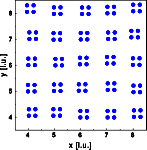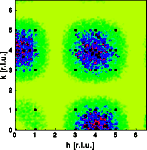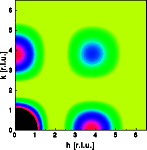Diffuse scattering: Thermal disorder II

Diffuse scattering
Thermal I
Thermal II
Occupational I
Occupational II
Longitudinal waves
Transversal waves
Short range order
Stacking faults
Interactive examples
Displacement waves
Short range order
Stacking faults
Goto
Contents



The Bragg reflections are shown as black dots, most of them are overexposed. Diffuse scattering results that is modulated in reciprocal space since the atoms are no longer moved independently. Note that the diffuse scattering is more intense at larger reciprocal vectors h and absent near the origin of reciprocal space. The modulation of the diffuse scattering can be explained by calculating the Fourier transform of a single rigid square molecule (right image above). This Fourier transform shows the same modulation as that of the diffuse scattering observed from the disordered crystal. In real space thermally disordered points are convoluted with the molecule. In real space the monotonous Laue scattering is multiplied by the Fourier transform of a single molecule. Since the monotonous Laue scattering is zero at the origin of reciprocal space, the diffuse scattering of this crystal is zero at the origin of reciprocal space as well.